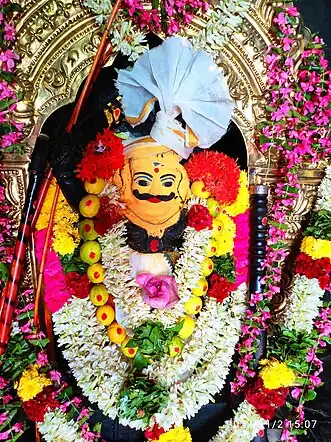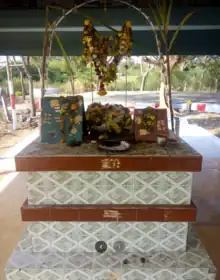Karuppu Sami
Karuppu Sami (lit. 'black deity') is a regional Tamil god, popular among the rural social groups of Tamil Nadu and parts of Kerala. He is one of the 21 associated folk-deities of Ayyanar, and is hence was one among the demigods or kaval deivams in the Tamil folk religion.[2] He is sometimes considered to be a form of Shiva among Shaivas.
| Karuppu Sami | |
|---|---|
Patroller of Boundaries[1] | |
 Idol of Karuppu Sami | |
| Affiliation | Tamil folk religion, Animism, Ancestor worship |
| Weapon | Aruval, Spear, Gada, Chain |
| Mount | Horse |

Temples and shrines
Karuppu Sami temple is mostly found in the outskirts of the Village. Usually, the whole village contributes to the maintenance of the temple. These temples/shrines do not have traditional Gopurams and have large statues of Gods with large eyes, holding weapons like bow and arrow, swords, sickle and other weapons. There could also be statues of 7 Kannimar goddesses/Saptha Kanniyar (7 virgins) and animals, often a hunting dog, a lion and horse alongside the main idol of Karuppu Sami.
Karuppu Sami worship is based on an ancient ancestral clan-based worship system, which has barely syncretised with Hindu tradition. For instance, most officiating priests are non-Brahmins, and derive from local lineages that had initiated the cult generations ago. The worship pattern is non-Vedic or non-Agamic through folk tales, songs and arts (Villu pattu, karakattam, koothu etc.). The local priest might offer flowers or vibhuti (holy ash) to the worshippers and may play the role of an oracle for Shamanism. Various persons within the clan system are identified to play to the role of oracle on annual turn basis. They undertake vradham and maintain chastity and purity during the period. During the festivals, oracles get into trance state (Sami adudhal) and deliver counselling messages to the group assembled there without bias. Before the oracles deliver counselling messages, oracles stand on top of the aruval (aruval mel vakku). The normal problems addressed are family problems, financial troubles and local community and social issues for resolving within the community group with the agreement of local ancestral god through oracle. Whenever the wishes of the people are granted, they give their offerings to him based on what they vowed to offer.
Karuppu Sami is also worshipped in Trinidad and Tobago, Guyana, Fiji, Mauritius, Réunion, Seychelles, Guadeloupe,Singapore,Malaysia and Martinique under the name Dee Baba, Sangili Karuppan, or Sangani Baba.
Annual festivals
The village committee would decide on when the annual festival be conducted. The time of the year when this would fall varies with villages and their local customs - each of which will be associated a folk-lore. Generally, the mass convention assembly of a large number of related family members is organized during the spring season for a period of 2 to 3 days. The commencement of the festival will be with that of a hoisting of the flag and tying the "Kaappu". After this time, villagers cannot go out of the village but can come in from a different village.
Trance
Trance is an important phenomenon that occurs in some forms of Karuppasamy worship, particularly the Non-Vedic ones. This phenomenon essentially enables the deity to possess the body of a human, who then goes on to display physical traits of the deity. This is usually done at major festivals or prayers, and is considered to be a clear sign of the physical presence or blessing of the deity. Some practitioners willingly invoke the deity into their bodies, while for others it happens without their control. Trance is also used as a platform for devotees to communicate with the deity and vice versa, to provide solutions and advises for a multitude of topics.
It is a highly Controversial Topic.
Forms Of Karuppasamy
Periya Karuppu,
Chinna Karuppu,
Sandhana Karuppu,
Sandi Karuppu,
Mandu Karuppu - are some of the forms of Karuppasamy.
Worship in Indo-Caribbean Madras Religion
In Caribbean Shaktism, called Madras Religion in Guyana,[3] He is known as Sanganie (some also call him Sangilli Karuppan). In the Indo-Caribbean community, particularly in Trinidad and Tobago, Guyana, Suriname, Guadeloupe, and Martinique, Sanganie Baba is revered and worshipped as a powerful deity.
Sanganie Baba is often associated with the color black, which symbolizes his fierce and protective nature. He is considered a guardian deity, offering his devotees protection, prosperity, and guidance. His worship in Indo-Caribbean Shaktism blends elements of Hinduism and folk traditions that have been passed down through generations. [4]
Devotees offer various items to Sanganie Baba as part of their worship. These offerings can include Vedic items such as camphor, butter, cloves, and ghee. However, non-Vedic offerings such as cigarettes and alcohol are also made to him in these regions, reflecting the syncretic nature of the worship. [5]
Sacrifices of black chickens or goats are sometimes made as part of rituals dedicated to Sanganie Baba, symbolizing the offering of life and the seeking of his blessings and favor. These practices reflect the deep connection and devotion of the Indo-Caribbean community to Sanganie Baba. [6]
In Indo-Caribbean Shaktism, Sanganie Baba is revered as a deity who can provide counsel and guidance. During festivals and special occasions, individuals chosen as oracles enter into a trance-like state, known as "Sami adudhal." In this state, they channel the messages and advice of Sanganie Baba to the assembled devotees, addressing their personal and community concerns. [7]
See also
References
- Possessed by the Virgin: Hinduism, Roman Catholicism, and Marian Possession in South India. Oxford University Press. 2018. ISBN 978-0-19-061509-3.
- Bloomer, Kristin C. (2018). Possessed by the Virgin: Hinduism, Roman Catholicism, and Marian Possession in South India. Oxford University Press. p. 291. ISBN 978-0-19-061509-3.
- "Kali/Mariamma Worship in Guyana: A Brief Overview" (PDF). Dr. Marcelo Moura Mello.
- "The Importance of Dee (Deeha) Baba Worship in Hinduism (Sanatan Dharma)" (PDF). Dipika. Narottam Das.
- "The Importance of Dee (Deeha) Baba Worship in Hinduism (Sanatan Dharma)" (PDF). Dipika. Narottam Das.
- "The Importance of Dee (Deeha) Baba Worship in Hinduism (Sanatan Dharma)" (PDF). Dipika. Narottam Das.
- "The Importance of Dee (Deeha) Baba Worship in Hinduism (Sanatan Dharma)" (PDF). Dipika. Narottam Das.

